《幼儿英语教学法》试卷(10)
《幼儿英语教学法》测试题及答案(二)

《幼儿英语教学法》测试题(二)一.填空题(每空1分,共10分)1.美国著名的教育家,心理学家布卢姆提出,把通过教学活动所要实现的整体教学目标分为三个主要的领域,即()领域,()领域和()领域。
2.()和()是幼儿英语课堂教学的两个主体要素。
3.全息全感儿童英语教学法可概括为24个字,采用(),制造(),调动(),注重()。
4.计算机辅助教学简称()。
二.简答题(每题5分,共15分)1.幼儿英语教学的目标有什么?2.简单说一说帮助幼儿理解英语故事的活动有哪些?3.谈一谈幼儿英语词汇教学的方法和技巧。
三、教学活动设计(每题20分,共20分)请以学过的幼儿英语歌曲《Rain, rain, go away》为题,设计一种使用方法。
四.填表题(每空5分,共25分)阶段教师的教学过程(全息教法)幼儿的学习过程(全感学法)一听感知和理解语音信息二设计机械训练的活动三语言材料的复用、活用五.口试题(每题30分,共30分)请以《London Bridge is falling down》为题,设计并组织一个幼儿英语游戏。
要求包括以下几个方面:游戏类型、游戏目的、游戏教具、幼儿年龄程度、游戏过程。
参考答案一.填空题(每空1分,共10分)1.认知、情感、动作技能2.教师、幼儿3.多种手段、交际动机、多种感官、无意学习4.CAI二.简答题(每题5分,共15分)1.答:(1)掌握少量的最基本的语言知识(2)发展听说语言技能(3)激励情意(4)学习策略(5)文化意识2.答:(1)听和做:让孩子们扮演故事中的某个角色。
(2)听和表演:让孩子们表演故事。
(3)听和辨认:让孩子们边听故事边指出故事中对应的图画。
(4)听和反应:孩子们听老师讲故事,听到老师讲错时让他们拍手。
(5)听和着色:让孩子们听从老师的指令给故事海报图颜色。
(6)听和画画:让孩子们画出小红帽篮子里的三件东西来。
(7)听和制作:可以让孩子们描慕并动手制作某个角色的面具。
《幼儿英语教学法》测试题及答案(四)
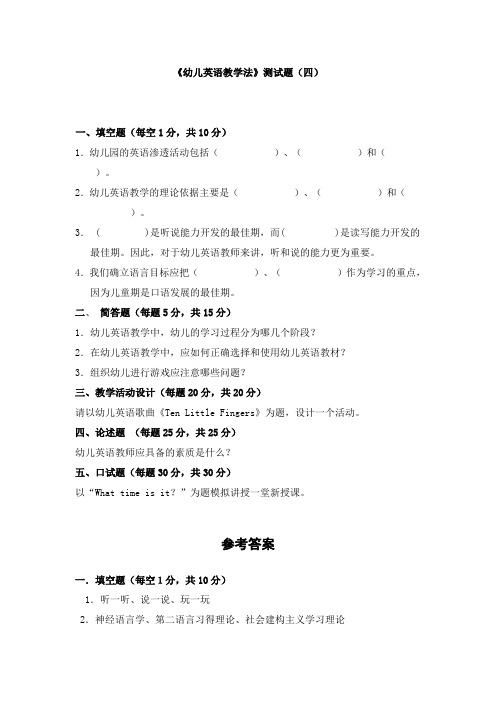
《幼儿英语教学法》测试题(四)一、填空题(每空1分,共10分)1.幼儿园的英语渗透活动包括()、()和()。
2.幼儿英语教学的理论依据主要是()、()和()。
3. ( )是听说能力开发的最佳期,而( )是读写能力开发的最佳期。
因此,对于幼儿英语教师来讲,听和说的能力更为重要。
4.我们确立语言目标应把()、()作为学习的重点,因为儿童期是口语发展的最佳期。
二、简答题(每题5分,共15分)1.幼儿英语教学中,幼儿的学习过程分为哪几个阶段?2.在幼儿英语教学中,应如何正确选择和使用幼儿英语教材?3.组织幼儿进行游戏应注意哪些问题?三、教学活动设计(每题20分,共20分)请以幼儿英语歌曲《Ten Little Fingers》为题,设计一个活动。
四、论述题(每题25分,共25分)幼儿英语教师应具备的素质是什么?五、口试题(每题30分,共30分)以“What time is it?”为题模拟讲授一堂新授课。
参考答案一.填空题(每空1分,共10分)1.听一听、说一说、玩一玩2.神经语言学、第二语言习得理论、社会建构主义学习理论3、学前期、学龄期4、听、说二.简答题(每题5分,共15分)1、答:(1)感知和理解语音信息(2)模仿并照原样说出(3)语言材料的复用、活用2、答:(1)幼儿英语教材的选择应注意:①主题鲜明,贴近幼儿日常生活;②有利于幼儿的全面发展;③有良好的配套材料;④教材具有连续性;⑤能够帮助组织教学过程。
(2)在使用幼儿英语教材时,应注意:①确立教学目标,避免教学的盲目性;②适当调整教学顺序,构建活动主题,体现幼儿的自主性;③对教材内容进行适当的补充、删减或者替换;④调整教学方法;⑤总结教材使用情况。
3、答:游戏的注意事项:(1)不为“玩游戏”而玩游戏,应配合上课内容,作加强学习的作用。
(2)选择适合幼儿水平的游戏,考虑幼儿的年龄、程度与兴趣。
(3)注意教室秩序及幼儿安全。
(4)将每次游戏时间控制于15分钟内,勿拖延过长。
《幼儿英语教学法》测试题及答案(三)
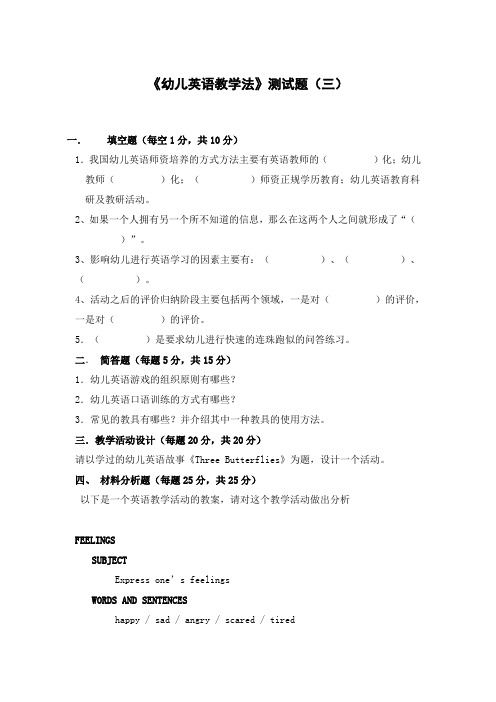
《幼儿英语教学法》测试题(三)一.填空题(每空1分,共10分)1.我国幼儿英语师资培养的方式方法主要有英语教师的()化;幼儿教师()化;()师资正规学历教育;幼儿英语教育科研及教研活动。
2、如果一个人拥有另一个所不知道的信息,那么在这两个人之间就形成了“()”。
3、影响幼儿进行英语学习的因素主要有:()、()、()。
4、活动之后的评价归纳阶段主要包括两个领域,一是对()的评价,一是对()的评价。
5.()是要求幼儿进行快速的连珠跑似的问答练习。
二.简答题(每题5分,共15分)1.幼儿英语游戏的组织原则有哪些?2.幼儿英语口语训练的方式有哪些?3.常见的教具有哪些?并介绍其中一种教具的使用方法。
三.教学活动设计(每题20分,共20分)请以学过的幼儿英语故事《Three Butterflies》为题,设计一个活动。
四、材料分析题(每题25分,共25分)以下是一个英语教学活动的教案,请对这个教学活动做出分析FEELINGSSUBJECTExpress one’s feelingsWORDS AND SENTENCEShappy / sad / angry / scared / tiredI’m happy/sad/…TEACHING-AIDSPictures for words and story / puppets / blue ribbon / croco dile (toy) / pianoLESSONGREETING:Good morning! How are you? Today, we have a friend here. Who is he?(Puppet behind. They may guess) I’m sure you know him, because you like playing ‘SIMON SAYS’. So who is he? Simon! Yes, it’s Simon. (S how them the puppet and say hello to them in Simon’s voice.) LEAD:Let’s play the game SIMON SAYS, ok? (Ok!)So, get ready. Are you ready? (Yes.) SIMOM says,“touch your shoes!” (In Simon’s voice) S IMON says,“clap your hands!” SIMON says,“stamp your feet!” SIMON says,“say ‘hurry’!” (Hide the ears with your hands) “clap your h ands!”(Touch those who act) SIMON says,“clap your hands!”… Look! SIMON is very HAPPY(show them the picture ‘HAPPY’, point beside your mouth, smile) Happy, Happy, do you remember the song“If you are happy”?(Yes) Good. Let’s sing together! Well, let’s get some music. Music! (Let your assistant play the piano) Get ready!(Sing the song with the kids) Goo d! Listen, when you are happy, maybe you clap your hands, but if you are not happy, what will you do? Clap your hands? No! So if you are n ot happy, you maybe SAD(Put on the picture ‘SAD’, two hands on your heart and show the m a sad face) SAD, SAD, SAD (in a sad voice, kids may follow you and act)If you are not happy, you may be SCARED(Put on the picture, two hands beside your ears, scream; show th em a toy crocodile and pretend it is going to bite them) If you are not happy, you may be ANGRY(Put on the picture, two hands on your waist, stamp your feet hea vily and make an angry voice)TIRED (put on the picture, pretend you are sleepy)ACTIVITY for LISTENING:YES or NO: (flash the picture, let them judge)“Happy?” (Yes)“SAD?” (No)…JUMP TO: Let’s play a game. Look! Here I put 5 pictures on the flo or, let’s play ‘JUMP TO’, ok? (Ok.)Volunteer! POLY, good. Come here. Please jump to ‘SAD’, jump to ‘ANGRY’…SIMON SAYS: Well, let’s stop here and play SIMOM SAYS.. Get ready. SIMON Says,“SAD”(kids act it out)SIMON Says,“ANGRY”…ACTIVITY for SPEAKING(Pick up the pictures) We stop here. (Review, flash the pictures) H APPY(say it and act it out, let the kids follow you)HAPPY, HAPPY!(Hol d up the picture, walk around the class, make sure every kid can see it and you can hear their pronunciation) …MIME:I need a volunteer comes here. TIM, come here, please take a l ook at this picture and act it out. (TIM looks at the picture and act it out without speaking) And you tell me what it is. (HAPPY or else)…IF MISS WANG…Everybody, look! If Miss Wang (pretend you are scared, let them say how you feel…)REVIEW:(flash the picture)COMMUNICATIONSTORY:Let me tell you a story. It’s about SIMON.(Show them the 1st story-picture) Look, this is SIMON! It is a very hot day and SIMON is very hot too. Look at the sun, he has put on hi s sunglasses, see? They are green and black. Since it is very hot, SI MON wants to swim. (2nd story-picture) So he says to Monkey,“Monkey, Monkey, let’s go swimming, ok?”Monkey says, “No!” So SIMON is ver y ‘SAD’ and he walks away. He walks and walks and he meets Duck. He says to Duck,“Duck, Duck, let’s go swimming, ok?” Duck says,“Ok!” This time SIMON is very ‘HAPPY’.“Oh, I’m happy!”(show them the 3rd story-picture) Look, they are swimming. They are very happy. When they see the Crocodile sleeping, they are scared! SIMON says,“Shi…b e quiet, do not wake it up.”(show them the 4th story-picture) But the crocodile wakes up, and he is very angry,“Hey, what are you doing!”S IMON and Duck run away. “Let’s run!” They run, run, and run home (s how them the 5th story-picture ) Look, they are very tired, and they g o to sleep. THE END.Well, let me ask you some questions.“What’s the boy’s name?”“Is it a cold day?”“What does the boy want to do?”“Does Monkey say ‘YES’ to the boy? Is he happy?”“Does the Duck say ‘YES’ to him? Is he ‘SAD’ or not?”“Is the Crocodile ‘HAPPY’ or ‘angry’?”DRAMA:I need some volunteer to act it out. Volunteer! …REVIEW:(flash the picture) JOANA, pretend you are SIMON, how do you feel? (Encourage them to say ‘I’m sad/tired/angry… ) MICHEALE, pr etend you are SIMON, how do you feel? …classify ‘ANGRY’ and ‘HUNGRY’‘ANGRY’ is not ‘HUNGRY’. Well, it’s snack time and maybe you a re hungry. So, let’s go and have the SANCK! Everybody follows me, Le t’s go!五.口试题(每题30分,共30分)请以《小餐厅》为题,设计并模拟一个幼儿英语游戏。
《幼儿英语教学法》测试题及答案(八)
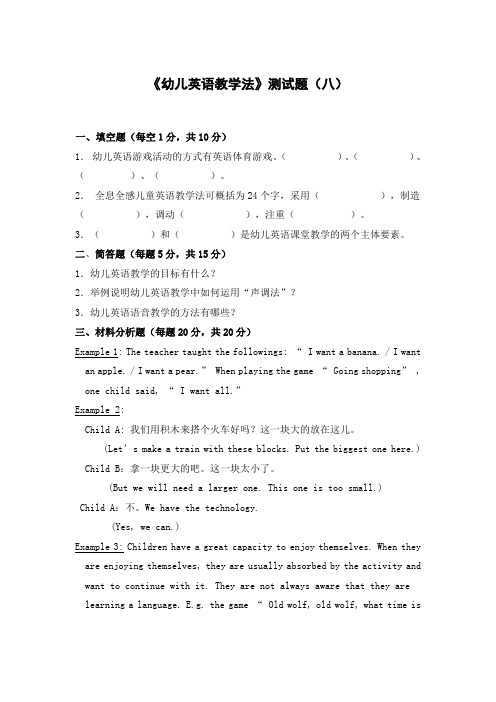
《幼儿英语教学法》测试题(八)一、填空题(每空1分,共10分)1.幼儿英语游戏活动的方式有英语体育游戏、()、()、()、()。
2.全息全感儿童英语教学法可概括为24个字,采用(),制造(),调动(),注重()。
3.()和()是幼儿英语课堂教学的两个主体要素。
二、简答题(每题5分,共15分)1.幼儿英语教学的目标有什么?2.举例说明幼儿英语教学中如何运用“声调法”?3.幼儿英语语音教学的方法有哪些?三、材料分析题(每题20分,共20分)Example 1: The teacher taught the followings: “ I want a banana. / I want an apple. / I want a pear.” When playing the game “ Going shopping” , one child said, “ I want all.”Example 2:Child A: 我们用积木来搭个火车好吗?这一块大的放在这儿。
(Let’s make a train with these blocks. Put the biggest one here.) Child B:拿一块更大的吧。
这一块太小了。
(But we will need a larger one. This one is too small.)Child A:不。
We have the technology.(Yes, we can.)Example 3: Children have a great capacity to enjoy themselves. When they are enjoying themselves, they are usually absorbed by the activity and want to continue with it. They are not always aware that they are learning a language. E.g. the game “ Old wolf, old wolf, what time isit?” When playing the game, the children seem to be really enjoying themselves.Example 4: If we watch children speaking in their first language, we notice how much they enjoy repeating. We often find a child talking to himself when playing. What happens to this when children learn another language. Here is an example: A three-year-old child had learned a rhyme “ A car, a car, a car car car. Di di di, chi…” When the child came back home, he just repeated it all the time even when he went to the toilet. 四、论述题(每题25分,共25分)幼儿英语游戏的设计应该考虑哪些方面?五、口试题(每题30分,共30分)请以“fat/thin, short/tall”两组形容词为内容,设计并组织一个幼儿英语游戏。
《幼儿英语教学法》试卷(2)

《幼儿英语教学法》试卷(2)班级姓名学号一.填空题(每空1分,共10分)1.我国幼儿英语师资培养的方式方法主要有英语教师的()化;幼儿教师()化;()师资正规学历教育;幼儿英语教育科研及教研活动。
2、如果一个人拥有另一个所不知道的信息,那么在这两个人之间就形成了“()”。
3、影响幼儿进行英语学习的因素主要有:()、()、()。
4、活动之后的评价归纳阶段主要包括两个领域,一是对()的评价,一是对()的评价。
5.()是要求幼儿进行快速的连珠跑似的问答练习。
二.简答题(每题5分,共15分)1.幼儿英语游戏的组织原则有哪些?2.幼儿英语口语训练的方式有哪些?3.常见的教具有哪些?并介绍其中一种教具的使用方法。
三.教学活动设计(每题20分,共20分)请以学过的幼儿英语故事《Three Butterflies》为题,设计一个活动。
四、材料分析题(每题25分,共25分)以下是一个英语教学活动的教案,请对这个教学活动做出分析FEELINGSSUBJECTExpress one’s feelingsWORDS AND SENTENCEShappy / sad / angry / scared / tiredI’m happy/sad/…TEACHING-AIDSPictures for words and story / puppets / blue ribbon / crocodile (toy) / pianoLESSONGREETING:Good morning! How are you? Today, we have a friend here. Who is he?(Puppet behind. They may guess) I’m sure you know him, because you like playing ‘SIMON SAYS’. So who is he? Simon! Yes, it’s Simon. (Show them the puppet and say hello to them in Simon’s voice.)LEAD:Let’s play the game SIMON SAYS, ok? (Ok!)So, get ready. Are you ready? (Yes.) SIMOM says,“touch your shoes!” (In Simon’s voice) SIMON says,“clap your hands!”SIMON says,“stamp your feet!” SIMON says,“say ‘hurry’!” (Hide the ears with your hands) “clap your hands!”(Touch those who act) SIMON says,“clap your hands!”… Look! SIMON is very HAPPY(show them the picture ‘HAPPY’, point beside your mouth, smile) Happy, Happy, do you remember the song“If you are happy”?(Yes) Good. Let’s sing together! Well, let’s get some music. Music! (Let your assistant play the piano) Get ready!(Sing the song with the kids) Good! Listen, when you are happy, maybe you clap your hands, but if you are not happy, what will you do? Clap your hands? No! So if you are not happy, you maybe SAD(Put on the picture ‘SAD’, two hands on your heart and show them a sad face) SAD, SAD, SAD (in a sad voice, kids may follow you and act)If you are not happy, you may be SCARED (Put on the picture, two hands beside your ears, scream; show them a toy crocodile and pretend it is going to bite them)If you are not happy, you may be ANGRY(Put on the picture, two hands on your waist, stamp your feet heavily and make an angry voice)TIRED (put on the picture, pretend you are sleepy)ACTIVITY for LISTENING:YES or NO: (flash the picture, let them judge)“Happy?” (Yes)“SAD?” (No)…JUMP TO: Let’s play a game. Look! Here I put 5 pictures on the floor, let’s play ‘JUMP TO’, ok? (Ok.)Volunteer! POLY, good. Come here. Please jump to ‘SAD’, jump to ‘ANGRY’…SIMON SAYS: Well, let’s stop here and play SIMOM SAYS.. Get ready.SIMON Says,“SAD”(kids act it out)SIMON Says,“ANGRY”…ACTIVITY for SPEAKING(Pick up the pictures) We stop here. (Review, flash the pictures) HAPPY(say it and act it out, let the kids follow you)HAPPY, HAPPY!(Hold up the picture, walk aroundthe class, make sure every kid can see it and you can hear their pronunciation) …MIME:I need a volunteer comes here. TIM, come here, please take a look at this picture and act it out. (TIM looks at the picture and act it out without speaking) And you tell me what it is. (HAPPY or else) …IF MISS WANG…Everybody, look! If Miss Wang (pretend you are scared, let them say how you feel…)REVIEW:(flash the picture)COMMUNICATIONSTORY:Let me tell you a story. It’s about SIMON.(Show them the 1st story-picture) Look, this is SIMON! It is a very hot day and SIMON is very hot too. Look at the sun, he has put on his sunglasses, see? They are green and black. Since it is very hot, SIMON wants to swim. (2nd story-picture) So he says to Monkey,“Monkey, Monkey, let’s go swimming, ok?”Monkey says, “No!”So SIMON is very ‘SAD’ and he walks away. He walks and walks and he meets Duck. He says to Duck,“Duck, Duck, let’s go swimming, ok?” Duck says,“Ok!” This time SIMON is very ‘HAPPY’.“Oh, I’m happy!”(show them the 3rd story-picture) Look, they are swimming. They are very happy. When they see the Crocodile sleeping, they are scared! SIMON says,“Shi…be quiet, do not wake it up.”(show them the 4th story-picture) But the crocodile wakes up, and he is very angry,“Hey, what are you doing!”SIMON and Duck run away. “Let’s run!” They run, run, and run home (show them the 5th story-picture ) Look, they are very tired, and they go to sleep. THE END.Well, let me ask you some questions.“What’s the boy’s name?”“Is it a cold day?”“What does the boy want to do?”“Does Monkey say ‘YES’ to the boy? Is he happy?”“Does the Duck say ‘YES’ to him? Is he ‘SAD’ or not?”“Is the Crocodile ‘HAPPY’ or ‘angry’?”DRAMA:I need some volunteer to act it out. Volunteer! …REVIEW:(flash the picture) JOANA, pretend you are SIMON, how do you feel? (Encourage them to say ‘I’m sad/tired/angry… ) MICHEALE, pretend you are SIMON, how do you feel? …classify ‘ANGRY’ and ‘HUNGRY’‘ANGRY’ is not ‘HUNGRY’. Well, it’s snack time and maybe you are hungry. So, let’s go and have the SANCK! Everybody follows me, Let’s go!五.口试题(每题30分,共30分)请以《小餐厅》为题,设计并模拟一个幼儿英语游戏。
幼师英语期末测试题

学前教育专业英语期末测试题班级:姓名:总分:Ⅰ.语言知识。
(共20小题,每小题1分,共20分。
)1). 从所给的A, B, C, D 四个选项中找出划线部分读音不同的一个。
( ) 1. A. pair B. year C. spare D. bear( ) 2. A. poor B. tour C. moor D. fear( ) 3. A. name B. play C. ride D. game( ) 4. A. bike B. but C. kind D. fly( ) 5. A. eat B. pick C. meet D. bee( ) 6. A. how B. cow C. now D. know( ) 7. A. buy B. boy C. noise D. oil( ) 8. A. food B. book C. root D. ruler( ) 9. A. short B. walk C. more D. hot( ) 10. A. car B. cut C. party D. park2). 从所给的A, B, C, D 四个选项中,选出可以填入空白处的最佳答案。
( ) 11. I don’t feel like anything these days.A. eatingB. to eatC. ateD. eats( ) 12. Everyone wants to see the flower show, ?A. doesn’t itB.don’t heC. don’t theyD. doesn’t they( ) 13. Would you like some more noodles? --- No, thanks. I .A. don’t want toB. can’t eatC. am fullD. would like to( ) 14. You may write to me or come to see me. Way will do.A. AllB. BothC. EitherD. Neither( ) 15. There are many in the hospital.A. women doctorB. women doctorsC. woman doctorsD. woman doctor( ) 16. The little boy regards this old man his grandfather.A. asB. withC. onD. for( ) 17. We should say “” when we ask for something.A. Excuse meB. PleaseC. PardonD. Hello( ) 18. His family is the city.A. far fromB. far awayC. nearbyD. away from( ) 19. Stop ! The teacher is coming.A. talkingB. to talkC. talkD. talks( ) 20. Why not friends with him?A. makeB. beC. haveD. takeⅡ.完形填空。
《幼儿教师英语口语》期末试卷及答案
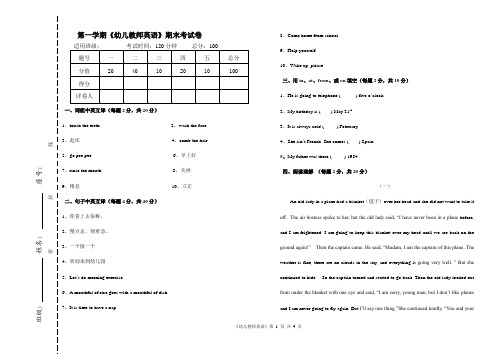
第一学期《幼儿教师英语》期末考试卷一、词组中英互译(每题2分,共20分)1、brush the teeth2、wash the face3、起床4、comb the hair5、go pee pee6、早上好7、rinse the mouth 8、关掉9、稍息10、立正二、句子中英互译(每题4分,共40分)1、你看上去很棒。
2、慢点走,别着急。
3、一个接一个4、欢迎来到幼儿园5、Let’s do morning exercise.6、A mouthful of rice goes with a mouthful of dish.7、It is time to have a nap. 8、Come home from school.9、Help yourself.10、Wake up, please.三、用in、at、from、或on填空(每题2分,共10分)1、He is going to telephone ( ) five o’clock.2、My birthday is ( ) May 21st3、It is always cold ( ) February.4、She isn’t French. She comes ( ) Spain.5、My father was there ( ) 1984.四、阅读理解(每题2分,共20分)(一)An old lady in a plane had a blanket(毯子)over her head and she did not want to take it off . The air hostess spoke to her, but the old lady said, “I have never been in a plane before, and I am frightened. I am going to keep this blanket over my head until we are back on the ground again!” Then the captain came. He said, “Madam, I am the captain of this plane. The weather is fine, there are no clouds in the sky, and everything i s going very well. ” But she continued to hide. So the captain turned and started to go back. Then the old lady looked out from under the blanket with one eye and said, “I am sorry, young man, but I don’t like planes and I am never going to fly again. But I’ll say one thing,”She continued kindly, “You and yourwife keep your plane very clean!”1. An old lady had _________ .A. glassesB. a blanket over her headC. a coatD. a basket2. A. She didn’t want to ________ .A. take it offB. turn it offC. get onD. talk about it3. _________ spoke to her .A. her husbandB.The man next to her.C. The air hostessD. one of her friends4. The old lady had never been _________ before .A. abroadB. homeC. in a planeD. in hospital5. The woman didn’t like planes and she was never going _____ .A. to go homeB. to fly againC. to go abroadD. to travel(二)In England, people often talk about the weather because they can experience (经历) four seasons in one day. In the morning the weather is warm just like in spring. An hour later black clouds come and then it rains hard. The weather gets a little cold. In the late afternoon the sky will be sunny, the sun will begin to shine, and it will be summer at this time of a day. In England, people can also have summer in winter, or have winter in summer. So in winter they can swim sometimes, and in summer sometimes they should take warm clothes. When you go to England, you will see that some English people usually take an umbrella (伞)or a raincoat with them in the sunny morning, but you should not laugh at them. If you don't take an umbrella or a raincoat, you will regret (后悔) later in the day.`6. Why do people in England often talk about the weather?A. Because they may have four seasons in one dayB. Because they often have very good weatherC. Because the weather is warm just like in springD. Because the sky is sunny all day7. From the story we know that when _________come, there is a heavy rain.A. sunshine and snowB. black cloudsC. summer and winterD. spring and autumn8. "People can also have summer in winter." Means "it is sometimes too ____in winter."A. warmB. coolC. coldD. rainy9. In the sunny morning some English people usually take a raincoat or an umbrella with them because ________.A. their friends ask them to do soB. it often rains in EnglandC. they are going to sell themD. they are their favourite things10. The best title (标题)for this passage is ________.A. Bad SeasonsB. Summer or WinterC. The Weather in EnglandD. Strange English People五、信息匹配(每题2分,共10分)( )1. How much does the hat cost? A、10 yuan( )2. How long is the river? B、I have two tickets.( )3. How often do you have English Class? C、About 500 KM( )4. How soon will you be back? D、Once a week( )5. How many tickets do you have? E、In an hour试卷答案一、词组中英互译(每题2分,共20分)1、brush the teeth 刷牙2、wash the face 洗脸3、起床get up4、comb the hair 梳头5、go pee pee 上厕所6、早上好good morning7、rinse the mouth 漱口8、关掉turn off9、稍息at ease 10、立正attention二、句子中英互译(每题4分,共40分)1、你看上去很棒。
学前英语教学法第五章幼儿英语课堂教学
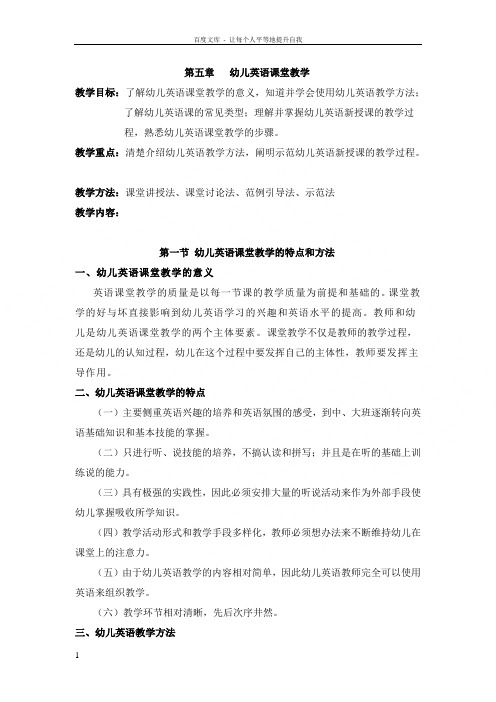
第五章幼儿英语课堂教学教学目标:了解幼儿英语课堂教学的意义,知道并学会使用幼儿英语教学方法;了解幼儿英语课的常见类型;理解并掌握幼儿英语新授课的教学过程,熟悉幼儿英语课堂教学的步骤。
教学重点:清楚介绍幼儿英语教学方法,阐明示范幼儿英语新授课的教学过程。
教学方法:课堂讲授法、课堂讨论法、范例引导法、示范法教学内容:第一节幼儿英语课堂教学的特点和方法一、幼儿英语课堂教学的意义英语课堂教学的质量是以每一节课的教学质量为前提和基础的。
课堂教学的好与坏直接影响到幼儿英语学习的兴趣和英语水平的提高。
教师和幼儿是幼儿英语课堂教学的两个主体要素。
课堂教学不仅是教师的教学过程,还是幼儿的认知过程,幼儿在这个过程中要发挥自己的主体性,教师要发挥主导作用。
二、幼儿英语课堂教学的特点(一)主要侧重英语兴趣的培养和英语氛围的感受,到中、大班逐渐转向英语基础知识和基本技能的掌握。
(二)只进行听、说技能的培养,不搞认读和拼写;并且是在听的基础上训练说的能力。
(三)具有极强的实践性,因此必须安排大量的听说活动来作为外部手段使幼儿掌握吸收所学知识。
(四)教学活动形式和教学手段多样化,教师必须想办法来不断维持幼儿在课堂上的注意力。
(五)由于幼儿英语教学的内容相对简单,因此幼儿英语教师完全可以使用英语来组织教学。
(六)教学环节相对清晰,先后次序井然。
三、幼儿英语教学方法(一)幼儿语言学习的特点1.幼儿会创造性地使用一门语言。
2.幼儿会不自觉地使用各种策略。
3.幼儿具有好奇心和参与意识。
4.幼儿喜欢重复。
(二)全息全感幼儿英语教学法概括为24个字:采用多种手段,制造交际动机;调动各种感官,注重无意学习。
(一)采用多种手段多种手段包括多种教学手段和多种教学方法。
“多种教学手段”包括:1.多种直观教具2.体态语3.情景创设。
“多种教学方法”包括:音乐游戏法、体育游戏法,唱、跳、画、讲故事、做手工、说唱法等各种各样的方法。
(二)制造交际动机讲解这个问题,涉及到“信息差”这个概念。
幼儿英语教育六大教学方法

幼儿英语教育六大教学方法幼儿英语教育六大教学方法1、环境熏陶法幼儿刚刚接触英语,对学习英语有一种神秘和畏惧感,担心自己听不懂英语,更不敢张嘴去说。
为了克服他们的这种心理,我们努力营造一种轻松、有趣、生动的学习环境。
将孩子们熟悉的一些卡通人物形象请到班内布置到墙面上,并配以英文说明;枯燥、抽象的英语字母、单词变换成卡通、拟人的形象,张贴、悬挂在教室相应的位置。
幼儿一进入教室,仿佛进入了英语的王国。
这种英语环境的潜移默化的影响,使幼儿对英语不再陌生神秘。
另外在与英语环境、玩具材料的交互作用中,幼儿耳濡目染地感受、习得英语,学习兴趣大增。
这种方法适用于任何年龄段的幼儿,但是对于幼儿园的师资水平、幼儿园和社区的人文环境要求较高。
幼儿园、幼儿的家庭和其所处的社区应该尽可能地为幼儿提供一个说英语的氛围,在这个环境中英语是幼儿与人交流的唯一工具,让幼儿不由自主地听、说、学英语,这样对幼儿英语水平的提高是最有帮助的。
2、形象直观法夸美纽斯曾说:“在可能的范围内,一切事物都应该尽量放到感官跟前。
”根据幼儿认知发展具体形象的特点,我们把教育内容以最直观、最生动的方式呈现给幼儿,充分发挥墙饰、实物、图片、玩具、操作材料、VCD光盘、录音带等的作用,让其直接作用于幼儿各种感官,调动幼儿多种感官参与活动,使具体感知与英语发音相结合,在语音和所表达的事物之间建立起直接联系,以减少幼儿掌握抽象语言的困难,激发幼儿学习兴趣和学习积极性。
我们针对幼儿的有意注意、坚持性及自制力发展较差的特点,制作了很多色彩鲜艳、外形夸张、可活动的直观形象的教具。
如嘴巴张开、胃口透明、可喂食物的小人、鲨鱼;可以活动的玩具汽车;形象逼真的冰激淋、蛋糕、糖果;可变换时间的大钟表;各种有趣的手偶、头饰等。
这些教具不仅形象逼真、幼儿易于理解、接受、有助于记忆,而且适合幼儿好奇、好动的特点,最大限度地调动了幼儿参与英语学习活动的积极性,增强了求知欲。
另外我们利用电视、电脑等现代媒体辅助教学,给幼儿以生动、形象、逼真的感官刺激,使幼儿满怀浓厚的情趣去接触语言符号,接受英语教育。
幼儿英语教学方法
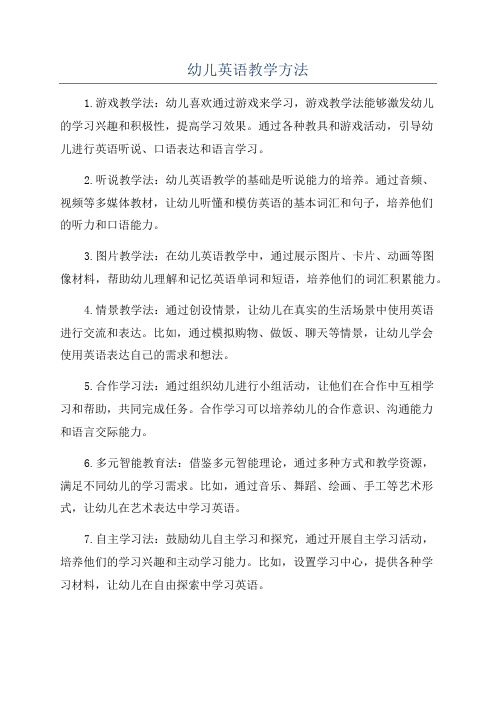
幼儿英语教学方法1.游戏教学法:幼儿喜欢通过游戏来学习,游戏教学法能够激发幼儿的学习兴趣和积极性,提高学习效果。
通过各种教具和游戏活动,引导幼儿进行英语听说、口语表达和语言学习。
2.听说教学法:幼儿英语教学的基础是听说能力的培养。
通过音频、视频等多媒体教材,让幼儿听懂和模仿英语的基本词汇和句子,培养他们的听力和口语能力。
3.图片教学法:在幼儿英语教学中,通过展示图片、卡片、动画等图像材料,帮助幼儿理解和记忆英语单词和短语,培养他们的词汇积累能力。
4.情景教学法:通过创设情景,让幼儿在真实的生活场景中使用英语进行交流和表达。
比如,通过模拟购物、做饭、聊天等情景,让幼儿学会使用英语表达自己的需求和想法。
5.合作学习法:通过组织幼儿进行小组活动,让他们在合作中互相学习和帮助,共同完成任务。
合作学习可以培养幼儿的合作意识、沟通能力和语言交际能力。
6.多元智能教育法:借鉴多元智能理论,通过多种方式和教学资源,满足不同幼儿的学习需求。
比如,通过音乐、舞蹈、绘画、手工等艺术形式,让幼儿在艺术表达中学习英语。
7.自主学习法:鼓励幼儿自主学习和探究,通过开展自主学习活动,培养他们的学习兴趣和主动学习能力。
比如,设置学习中心,提供各种学习材料,让幼儿在自由探索中学习英语。
8.全脑教育法:通过运用脑科学的理论和方法,激发幼儿的整体思维和创造力,培养他们的综合学习能力。
比如,通过运动、游戏和音乐等活动,促进幼儿在英语学习中的身体协调和注意力集中。
通过以上教学方法的综合运用,可以提高幼儿英语教学的效果,培养幼儿的英语听说能力、交际能力和语言表达能力。
幼儿英语的教学方法有哪些
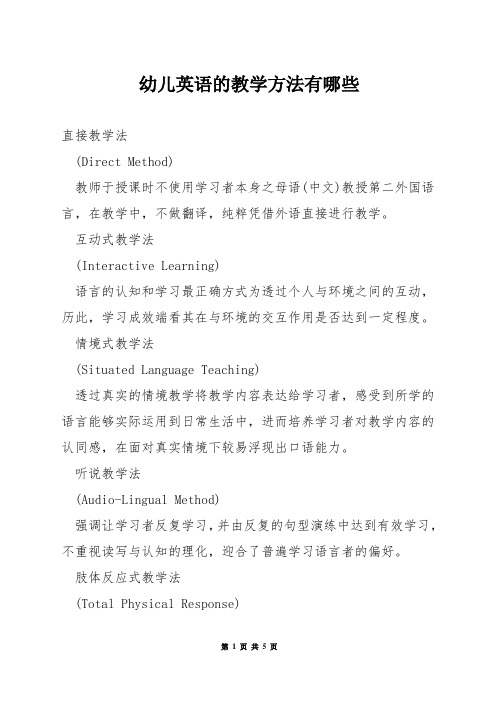
幼儿英语的教学方法有哪些直接教学法(Direct Method)教师于授课时不使用学习者本身之母语(中文)教授第二外国语言,在教学中,不做翻译,纯粹凭借外语直接进行教学。
互动式教学法(Interactive Learning)语言的认知和学习最正确方式为透过个人与环境之间的互动,历此,学习成效端看其在与环境的交互作用是否达到一定程度。
情境式教学法(Situated Language Teaching)透过真实的情境教学将教学内容表达给学习者,感受到所学的语言能够实际运用到日常生活中,进而培养学习者对教学内容的认同感,在面对真实情境下较易浮现出口语能力。
听说教学法(Audio-Lingual Method)强调让学习者反复学习,并由反复的句型演练中达到有效学习,不重视读写与认知的理化,迎合了普遍学习语言者的偏好。
肢体反应式教学法(Total Physical Response)语音的传达用动作表示,可以凭借学习者的肢体动作来反应来其学习的成效,同时透过右脑足够的肢体反应的刺激,能有助于学习者左脑的发展和语言学习的效果。
2幼儿英语的教学方法〔沟通〕式教学法(Communicative)强调沟通技巧的训练,因为优良的沟通能力,不仅是表达看法,或具备语法能力,还要具备语言的多样的功能:运用信息互补、自由选择、反馈等方式,达到真正沟通的目的。
自然教学法(Natural Approach)提供语言学习环境,包括:视觉、听觉、学习机会等,同时必须要使用同学能理解的语言教学,活动〔制定〕要有趣、引起同学学习的动机;着重有意义的输入,而非机械式的学习。
字母拼读法(Phonics)字母拼读法是一切教学法的起源,如同英文字母是英语的起源一般,因此同学可能凭借此来培养读与写的能力。
歌谣韵文教学法(Songs And Rhymes Teaching)凭着与主题相关的歌曲或韵文,复习学过的单字或句型,更能熟悉语调、节奏感和韵律感;提升学习兴趣和引起学习动机。
关于幼儿英语的教学方法

关于幼儿英语的教学方法幼儿英语教学是一门复杂而有挑战性的任务。
幼儿的学习能力、兴趣和注意力有限,所以需要使用一些特殊的教学方法来帮助他们学习英语。
下面是一些有效的教学方法,可以帮助幼儿学习英语。
1.游戏化教学法:通过游戏来教授英语是幼儿英语教学中普遍采用的方法。
游戏可以提高幼儿的兴趣和参与度,使他们更乐于学习。
例如,可以使用卡片配对游戏、拼图游戏、角色扮演等方法来教授英语单词和句子。
2.多媒体教学法:幼儿对于视觉和听觉刺激更为敏感,所以可以使用多媒体教材来辅助教学。
可以使用配有图像和动画的PPT和视频,来展示英语单词、句子和故事。
这样可以增加学习的趣味性和吸引力。
3.歌曲和音乐教学法:幼儿喜欢听音乐,所以可以通过唱歌和跟着音乐节奏进行动作来教授英语。
适合幼儿学习的英文歌曲和童谣能够让幼儿更好地记住英语单词和句子。
4.故事教学法:幼儿喜欢听故事,可以使用故事教学法来教授英语。
可以选择一些简单的英文故事,并通过图画、道具和动作来生动地讲故事。
在讲故事过程中可以穿插英文单词和句子的教学,帮助幼儿理解和记住英语。
5.视频教学法:幼儿对于电视和平板电脑上的视频比较感兴趣,所以可以使用英语教学视频来辅助教学。
可以选择一些有趣且适合幼儿观看的英语教学视频,通过观看视频学习英语单词、句子和日常对话。
6.情境教学法:幼儿学习英语的关键是要使学习变得有意义和实际。
可以将英语学习融入到幼儿的日常生活中。
例如,在幼儿园教学时可以模拟购物、洗衣、做饭等生活情境,让幼儿用英语进行交流和互动。
7.小组合作学习法:幼儿在小组中互动和合作的过程中更容易学习和记住英语。
可以将幼儿分成小组,让他们一起完成英语游戏、歌曲和故事的学习任务。
通过小组合作,不仅可以激发幼儿们的学习兴趣,还可以培养他们的合作能力和沟通能力。
8.多感官教学法:幼儿通过多个感官接受信息会更容易学习。
可以通过触摸、闻和尝尝试教授英语单词和句子。
例如,可以准备一些具有特殊气味的物品,让幼儿闻一闻并说出对应的英文单词。
《幼儿英语教学法》测试题及答案(五)

《幼儿英语教学法》测试题(五)一、填空题(每空1分,共10分)1.()是以纲要的形式编写的有关学科教学内容的指导性文件。
2.“情境参与”从三个方面来看,有()体验,()体验,()体验。
3.手偶和指偶在幼儿英语教学中的作用有:()、()、()和()。
4.设计有趣的环境。
分三种:一是物质环境;二是()环境;三是()环境。
二、简答题(每题5分,共15分)1.全息全感幼儿英语教学法的特点是什么?2.介绍几种幼儿英语语法教学的方法。
3.举例说明幼儿英语教学中如何运用“声调法”?三、材料分析题(每题20分,共20分)Example 1: The teacher taught the followings: “ I want a banana. / I wa nt an apple. / I want a pear.” When playing the game “ Going shopping” , one child said, “ I want all.”Example 2:Child A: 我们用积木来搭个火车好吗?这一块大的放在这儿。
(Let’s make a train with these blocks. Put the biggest one here.)Child B:拿一块更大的吧。
这一块太小了。
(But we will need a larger one. This one is too small.)Child A:不。
We have the technology.(Yes, we can.)Example 3: Children have a great capacity to enjoy themselves. When t hey are enjoying themselves, they are usually absorbed by the activity and want to continue with it. They are not alwaysaware that they are learning a language. E.g. the game “ Old wolf, old wolf, what time is it?” When playing the game, the children seem to be really enjoying themselves.Example 4: If we watch children speaking in their first language, we noti ce how much they enjoy repeating. We often find a child talking to himself when playing. What happens to this when children learn another language. Here is an example: A three-year-old child had learned a rhyme “ A car, a car, a car car car. Di di di, chi…” When the child came back home, he justrepeated it all the time even when he went to the toilet. 四、论述题(每题25分,共25分)在幼儿英语教学中应该如何选择和使用歌谣?五、口试题(每题30分,共30分)请以“triangle, square, round”等图形为内容,设计并组织一个幼儿英语游戏。
幼儿英语教学法讲义
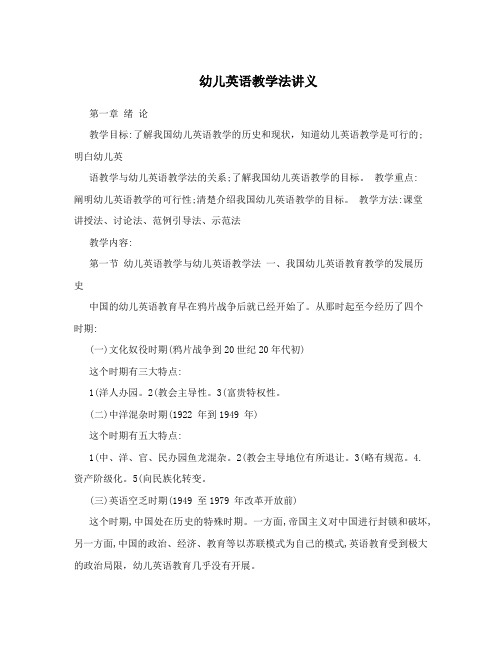
幼儿英语教学法讲义第一章绪论教学目标:了解我国幼儿英语教学的历史和现状,知道幼儿英语教学是可行的;明白幼儿英语教学与幼儿英语教学法的关系;了解我国幼儿英语教学的目标。
教学重点:阐明幼儿英语教学的可行性;清楚介绍我国幼儿英语教学的目标。
教学方法:课堂讲授法、讨论法、范例引导法、示范法教学内容:第一节幼儿英语教学与幼儿英语教学法一、我国幼儿英语教育教学的发展历史中国的幼儿英语教育早在鸦片战争后就已经开始了。
从那时起至今经历了四个时期:(一)文化奴役时期(鸦片战争到20世纪20年代初)这个时期有三大特点:1(洋人办园。
2(教会主导性。
3(富贵特权性。
(二)中洋混杂时期(1922 年到1949 年)这个时期有五大特点:1(中、洋、官、民办园鱼龙混杂。
2(教会主导地位有所退让。
3(略有规范。
4.资产阶级化。
5(向民族化转变。
(三)英语空乏时期(1949 至1979 年改革开放前)这个时期,中国处在历史的特殊时期。
一方面,帝国主义对中国进行封锁和破坏,另一方面,中国的政治、经济、教育等以苏联模式为自己的模式,英语教育受到极大的政治局限,幼儿英语教育几乎没有开展。
(四)逐渐规范化时期(20 世纪七、八十年代之交的改革开放至今)主要特点有:1(理论上百家争鸣。
2(幼儿英语教材的编写争芳斗艳。
3(英语师资队伍初步形成雏形。
4(幼儿英语教育模式呈现五彩斑斓的景象。
5(教学方法绚丽多姿。
6(幼儿英语教育教学手段日趋现代化、电子科技化。
7(幼儿英语教育机构的性质呈现多样化态势。
在幼儿英语教育层面上,国家虽然尚未做出明确规定要求开设英语,但是,社会需要的发展和近20 年幼儿英语教育的发展,已使幼儿园英语教育的必要性和可行性成为广大学者、社会、教师的广泛共识。
二、幼儿英语教学的必要性和可行性(一)外语学习对幼儿语言、认知和社会性发展具有促进作用外语学习对幼儿语言方面发展的促进作用,具体表现在:1.促进幼儿语言能力的提高。
2.外语学习对幼儿认识方面的发展表现在:一是促进对事物的概括化、概念化能力的发展。
幼儿英语教学方法
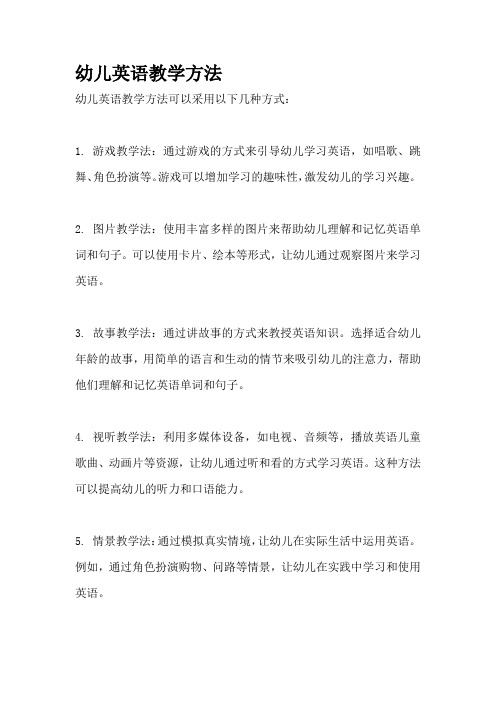
幼儿英语教学方法
幼儿英语教学方法可以采用以下几种方式:
1. 游戏教学法:通过游戏的方式来引导幼儿学习英语,如唱歌、跳舞、角色扮演等。
游戏可以增加学习的趣味性,激发幼儿的学习兴趣。
2. 图片教学法:使用丰富多样的图片来帮助幼儿理解和记忆英语单词和句子。
可以使用卡片、绘本等形式,让幼儿通过观察图片来学习英语。
3. 故事教学法:通过讲故事的方式来教授英语知识。
选择适合幼儿年龄的故事,用简单的语言和生动的情节来吸引幼儿的注意力,帮助他们理解和记忆英语单词和句子。
4. 视听教学法:利用多媒体设备,如电视、音频等,播放英语儿童歌曲、动画片等资源,让幼儿通过听和看的方式学习英语。
这种方法可以提高幼儿的听力和口语能力。
5. 情景教学法:通过模拟真实情境,让幼儿在实际生活中运用英语。
例如,通过角色扮演购物、问路等情景,让幼儿在实践中学习和使用英语。
6. 多元智能教学法:根据幼儿的不同智能类型,采用多种教学方法来满足他们的学习需求。
例如,对于视觉智能的幼儿,可以使用图片和图表来辅助学习;对于动手智能的幼儿,可以进行手工制作等活动来学习英语。
以上是一些常用的幼儿英语教学方法,教师可以根据幼儿的兴趣和特点选择合适的方法来进行教学。
《幼儿英语教学法》测试题(含答案)

然后说再见。
3.在音乐伴奏下,幼儿分别藏在房子、滑梯、树、山的后面自由表演。
4.在音乐伴奏下, 幼儿分别从树、 房子等后面跑出来, 去找一个朋友, 见面握手并互相问好, 各自介绍自己名字。如: “ Hello. I am Jane. Very nice to meet you. Byebye. ”
5.游戏可重复玩几遍,教师应提示幼儿每次游戏最好要找一个新朋友。 四.论述题 (每题 25 分,共 25 分)
2.通过游戏,巩固已学的英语单词及对话,培养幼儿对英语的兴趣。
3.提高幼儿的仿效能力,培养幼儿的合作精神。 游戏过程:
1.先复习歌曲《 Looking for a friend 》。
2.幼儿在音乐伴奏下, 两个人一组依次走到圆圈内互相问好并介绍自己的名字, 如:“ Hello, I am Tom. Very nice to meet you. Byebye. ”
);来自(
);来自(
)
二. 简答题(每题 5 分,共 15 分)
1.幼儿英语教师的必备素质有哪些? 2.幼儿英语教学中,教师的教学过程分为哪几个阶段? 3.语音教学有哪些方法和技巧? 三、教学活动设计(每题 20 分,共 20 分) 请以《 Looking for a friend 》为题,设计一个幼儿英语游戏。要求包括以下几个方面:游戏类 型、游戏目的、游戏教具、幼儿年龄程度、游戏过程。 四.论述题 (每题 25 分,共 25 分)
幼儿英语教学法》测试题(一)
关于考试的说明
《幼儿英语教学法》 是一门专业基础课, 主要侧重幼儿英语教学理论水平的提高和专业技能 的培养,使学生在修完本课程之后,能够掌握幼儿英语教学的基本方法和操作技能、技巧, 形成运用科学的理论知识指导幼儿英语教学实践、 提高分析解决幼儿英语教育教学实际问题 的能力。因此本门课程采取口试、笔试相结合的形式。
- 1、下载文档前请自行甄别文档内容的完整性,平台不提供额外的编辑、内容补充、找答案等附加服务。
- 2、"仅部分预览"的文档,不可在线预览部分如存在完整性等问题,可反馈申请退款(可完整预览的文档不适用该条件!)。
- 3、如文档侵犯您的权益,请联系客服反馈,我们会尽快为您处理(人工客服工作时间:9:00-18:30)。
《幼儿英语教学法》试卷(10)
班级姓名学号
一.填空题(每空1分,共10分)
1.幼儿英语课的常见课型有(),()和()。
2.幼儿英语教学以()为基础来培养幼儿的交际能力,因为语言的()是语言最本质的功能。
3.幼儿英语教学的理论依据主要是()、()和()。
4.言语交际包括两个相互联系,共同存在的过程,即()和()
二.简答题(每题5分,共15分)
1.幼儿英语教学趣味性原则包括哪四个方面?
2.幼儿英语教学中,幼儿的学习过程分为哪几个阶段?
3.幼儿英语活动课的主要特点是什么?
三.教学活动设计(每题20分,共20分)
请把传统体育游戏《老狼,老狼几点了》改成英语游戏。
四.论述题(每题25分,共25分)在实施幼儿英语歌谣活动时,应该注意哪些问题?
五.口试题(每题30分,共30分)
以“happy, sad, angry, mad”为题模拟讲授一堂新授课。
试卷第 1 页共 1 页。
